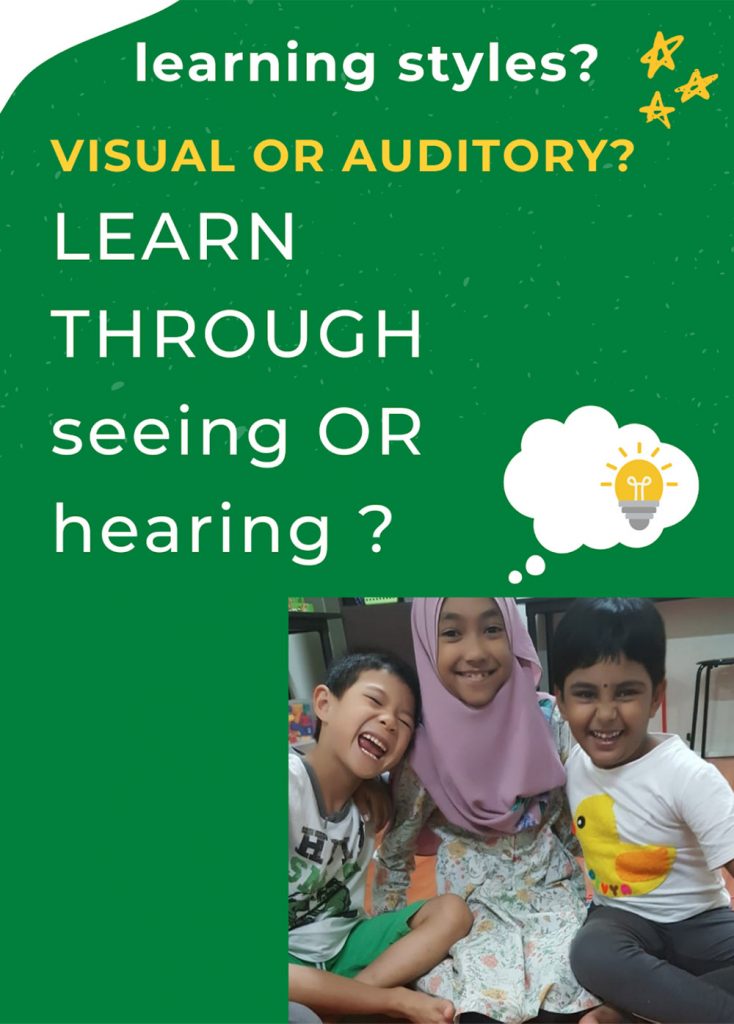Like us adults, children receive input, process and retain information in various styles, whichever they dominantly prefer. Today I want to highlight the four main types of learning styles. Recognize, no one child learns only in one style but that most favor one over another. Honing all these styles can help the child in class to learn better as one teacher may use one approach of learning more than another and all in his class will have to follow along.
First let us classify the four main types of learning styles according to VARK Modalities Theory, developed by Flemings and Mills:
- Visual Learners – prefer to learn by seeing and observing pictures, diagrams and symbols. They tend to have vivid imaginations and often think pictorially.
- Auditory learners – are auditory processors and learn through listening. They can be vocal and participate actively, sometimes to the annoyance of the teacher who just wants to ramble to finish what he sets off for the day.
- Kinesthetic learners – or also called tactile learners, like to use their hands to touch or act out what they are learning. It is through doing and moving that they learn best and find it easier to form abstracts from the concrete and understand the concepts better.
- Reading/Writing learners – learn best through words and are either avid readers or copious note-takers. Teachers’ notes are a welcome but their own will make learning more meaningful to them.

We are a little of the four here (though there are another four more. This will have to be another day) but we are focusing on these four main styles of learning only.
Critical is early childhood and pre-primary stages. Young children should be given maximum opportunities to be exposed to the different learning approaches. It hones all aspects of the brain to be trained and also helps these kids learn from the different styles that will be presented to them in school in later years. So, I encourage parents and teachers to stretch as best, kids’ formative years with the most conducive environment for learning. To say we have succeeded is to have children say they look forward to going to school or to a particular class, as they find learning fun there and they get to freely express themselves to thinking, figuring and solving.

A list of varied activities to help early learners tap on the varied learning styles include:
- Pre-made or process-drawn charts and diagrams to depict a point/theme will play up the sight element.
- Let children draw and even doodle for they may be assimilating while doodling. Do not reprimand them. Find out why they doodle.
- Color coding is good so have available lots of colored pens.
- Even let them come up to the board to draw and then explain.
- Have the children repeat back to see if they have caught your message.
- Allow children to raise their hands for questions and create a healthy climate of children answering others’ answers.
(Remind them it is okay to be wrong for sometimes inventions come out from mistakes)
- At home or in class include a myriad of experiences for your kids (for example, reading corner, manipulatives/fine motor area, art and craft zone. If not possible, make some lessons different focusing on some learning style not commonly done in class)
- The pupils writing out answers and later presenting will help them to prepare in their heads and the presentation segment will build confidence and allow them to think on their feet.
- Have hands-on activities and experiments in order for them to engage all their senses but most of all, the movement portion will allow the kinesthetic learners a chance at the game.
- Use of role-playing, flashing cards, memory games and discussions will brighten up the kids’ class sessions or home activities.
- Most of all, encourage reading and writing. Both are becoming a lost art. Adults, too, do not read and write outside work matters. Start being models and also make the activity interactive. Read together and encourage writing messages as parent-child or teacher-pupil.
Understanding these different learning styles is not the job of solely the teachers so parents can shun this responsibility. By equipping students with strong cognitive tools in their early years, much like skilled artisans, we all can jointly play our parts in empowering our future generation for their future.

Conclusion
We have mainly summarized the four main types of learning styles according to the VARK model. – Visual (V), Auditory (A) , Read-write (R) , Kinesthetic (K) . Understanding these different learning styles is not the job of solely the teachers but it is good for parents to know, too. By equipping students with strong cognitive tools in their early years, much like skilled artisans, we all can jointly play our parts in empowering our future generation. Here in Thinking Beyond, we have the means to assess children’s learning profiles and offer customized programs to address imbalance in cognitive aspects which may impede a child’s effective learning.
Children are unique learners, so make your lessons unique too.
